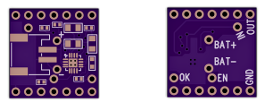OK, so I confess that I'm looking to be lazy here. The t3.0 schematic shows a 500mA fuse I'm at risk of popping, but knowing that it draws very little current, I tried powering a 74HCT245 off of the VIN pin and it seems to work fine. I'm still using a 0.1uF cap between Vcc and GND as would normally would.
I know this clearly isn't the intent of the circuit layout and I should be using VUSB (which I did in my initial testing), but nothing in the schematic screamed "don't do it!" to me, and it's SO much more convenient to leverage VIN than VUSB as a +5V when the T3 is plugged into a breadboard!
I know this clearly isn't the intent of the circuit layout and I should be using VUSB (which I did in my initial testing), but nothing in the schematic screamed "don't do it!" to me, and it's SO much more convenient to leverage VIN than VUSB as a +5V when the T3 is plugged into a breadboard!


